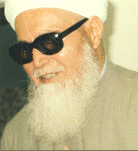

| Sh. Badr al
Deen al Hasani | Sh. Mahmoud Rankousi | Sh. Husain Sa'biyyah |
1329-1405 H (1910-1985 AD)
 Shaikh Mahmoud
Ba'youn al Rankousi Shaikh Mahmoud
Ba'youn al Rankousi
(by Orfan Rabbat)
Before presenting some information about
Shaikh Mahmoud Rankousi and his life, May Allah have mercy on him, an important comment
must be made about his impact on my life and on the lives on most of those who got to know
him.
The Islamic nation abounds, walhamdu lillaah,
with righteous scholars that have been outstandingly good models for their students and
aquaintances, and I have known quite a few and respect them deeply. When I reflect about
Shaikh Mahmoud, I find features that make him belong in a very special class.
The more I got to know him, and the more I got
to knowing Islam, I kept seeing how EVERY action of his was derived from the Quran or the
Sunnah, and if no text was available from these sources, he would be acting according to
some "weak" hadeeth. This "real life" example of the Sunnah had a
singular feature about it: It had a simplicity and "beauty" that forced on me,
time after time, a feeling of deep acceptance and tranquility. The way he
"lived" the Sunnah clarified its beauty and validity more than can ever be
explained in books. Furthermore, I used to ask him frequently about subjects of
controversy or hardship, and each time he would answer, I would be surprised to realize
the same feeling of deep acceptance inside me, and find myself thinking: If the Prophet
salla Llaahu `alaihi wa sallam was present today, and was asked about this, he would
undeniably have given this answer.
Several times I ask myself why am I being so
positive, and I always notice it is because his answers and his application of the Sunnah
always come in harmony with all that I have learned from the Sunnah and Quran. And the
more I learned, the more I found out how this was true concerning any action or answer of
his.
From knowing him in this manner, I have come
to believe that the beauty and "truth" of the noble Sunnah, brings with it
certitude about its truth, just like seeing the Prophet salla Llahu `alaihi wa sallam in a
dream brings with it certitude about its truth. He said, salla Llahu `alaihi wa sallam,
"Whoever has seen me in a dream, he has seen the truth; for the shaitan can not take
my image."
In other words, when one sees the Prophet in a
dream, he knows with undeniable certitude that he has seen the truth, and I feel that when
one perceives the true Sunnah applied in daily life, he knows with similar certitude that
it is the truth.
Other persons who have met such "living
examples" of the Sunnah must have experienced the same features that I did, and for
this we thank Allah for making his true religion crisp and clear to those who approach it
with a sane heart. I therefore pray Allah to accept the above description of Shaikh
Mahmoud's influence as a praise to Allah's infinite Mercy, more than a praise to the man
himself, Aameen.
Shaikh Mahmoud Rankousi
was born in 1329 Hi, 1910 AD, in Rankous, a village 45 km North West of Damascus.
His family descended from the tribe of al
Ansaar: the "supporters" who supported the Prophet salla Llaahu `alaihi wa
sallam and his companions who migrated from Maccah to Madeenah ("al
Muhaajireen").
He once told us that one of his righteous
ancestors had an unusual ability to "perceive" by touching, so he was called
"Ba`youn" (the person with eyes), which became his family name.
Shaikh Mahmoud's mother died when he was 2 years of age.
His youth was exceptionally protected by Allaah Ta`aala from what otherwise would be
considered "normal" straying or mistakes.
His father, Shaikh Qasim Ba`youn was a
righteous man. He took special care of his son, and enlisted him in the Quranic
memorization class. Shaikh Mahmoud memorized the Quran when he was 5 years old.
One day his father was told about Shaikh
Badru'd Deen al Hasani, the great Hadeeth scholar in Dar el Hadeeth, Damascus. Shaikh
Qasim was planning to go study under him, and was discussing it when Shaikh Mahmoud told
him, "It may be better if I go."
His father asked him, "Why?"
He answered, "I am still young (he was
about 12 years of age) and can remember more..."
His father was pleased and took him personally
to Shaikh Badr-u-Deen at the school of Dar el Hadeeth. Since then, he remained and lived
there, under Shaikh Badru'd Deen's personal supervision, whose house was connected by a
door to the school.
Although the level of Islamic learning was
high at the time, some topics taught by Shaikh Badru'd Deen were of such difficulty that
only Shaikh Mahmoud was able to finish them.
After the death of Shaikh Badru'd Deen, he
remained in Dar el Hadeeth and helped rebuild it, to allow for more students. He also
became one of Shaikh Abul-Khair al Maydaani's closest students, took the Naqsh-Bandi way
from him, and became one of his foremost successors.
Shaikh Mahmoud once said that he saw the
Prophet sall Llaahu `alaihi wasallam in a dream where he "gave him" his tongue
(the symbol of "speaking the Sunnah"). Indeed, when he used to narrate the
Hadeeth, it was as if a door was opening, allowing the listener to directly perceive the
splendor of our Prophet's wisdom and character. Indeed, he was besaught by foremost
scholars from all over the world, seeking Hadeeth and Islamic Sciences as well as the
Naqshbandi Way.
| Sh. Badr al
Deen al Hasani | Sh. Mahmoud Rankousi | Sh. Husain Sa'biyyah |
|
 Shaikh Mahmoud
Ba'youn al Rankousi
Shaikh Mahmoud
Ba'youn al Rankousi